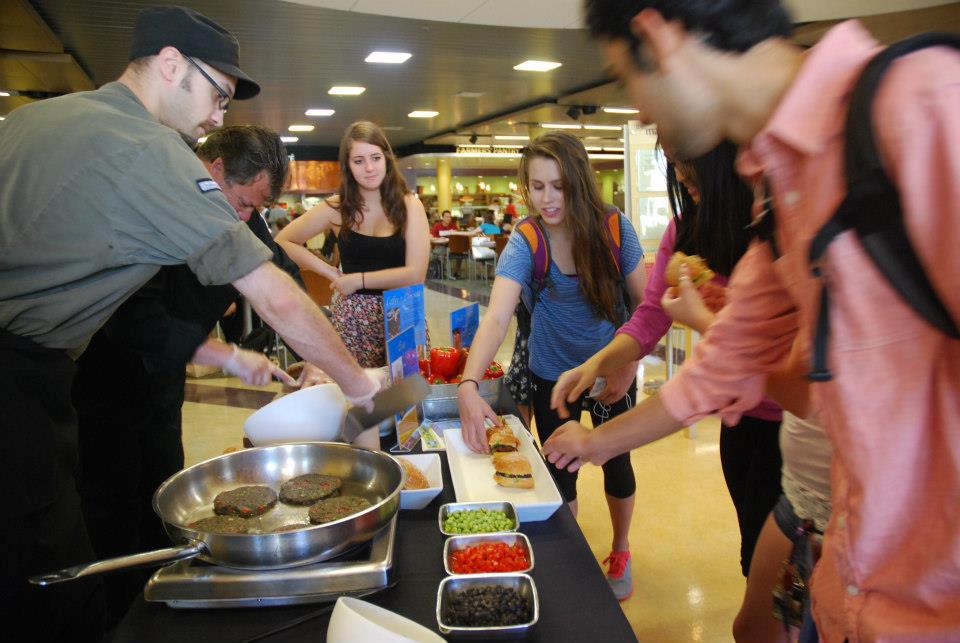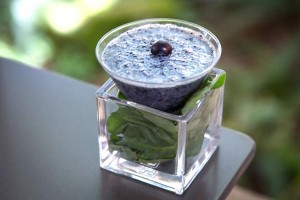A Hot New Twist on Low Carbon Diet Day

Santa Clara University students snatch up a custom edamame-black bean burger for Low Carbon Diet Day
Last May, I was standing in some strawberry fields in Salinas, CA, listening to Tony Serrano of ALBA Organics talk about seeing the effects of climate change in just the past decade. Ten years ago, the farmers he works with hadn’t been able to grow strawberries in certain areas because it was too cold for them — and now it’s not. “But the biggest manifestation comes in the radical changes in weather,” Tony said. “Sometimes we see a 20-degree difference from one day to the other.”
A young colleague of mine went to Colombia to see where the Cordillera Fair Trade Certified chocolate we use for baking comes from, and came back worried about the cacao industry’s contribution to climate change as well as its effect on farmers.
A friend at Thanksgiving Coffee, an artisan coffee roaster in California, shared the amazing work Thanksgiving is doing with its Rwandan coffee growers to adapt to increased temperatures, shorter ripening periods, and losses in complexity of flavor.
For me, these stories meant climate change stopped being an abstract scientific concept or an animated picture of a polar bear on melting ice cap far, far away and instead pulled up a seat at my table.
I wanted others to make this connection. Food can be a terrific vehicle to use for educating people about complex topics, and luckily, I work for a company that has an army of chefs who enjoy just this kind of challenge. Bon Appétit was the first food service company to address food’s role in climate change, with the Low Carbon Diet program we put ourselves on starting in 2007. And a year after, we started holding a companywide education event we call Low Carbon Diet Day. Every year around Earth Day, our chefs change their menus and explain to their diners at corporations, colleges and universities, and museums in 32 states how their every day food choices affect our planet.
For Earth Day today, we’re doing something a little different. Our chefs are standing in front of guests at a cooking demonstration table, making almond-milk-fruit smoothies, cheeseless pizzas, and edamame burgers with carrot peel toppings. They’re talking about how climate change isn’t just this storm gathering way down the road, it’s here and it’s affecting some of our favorite foods. Maybe Tony is happy that his farmers can grow strawberries in more areas now, but the stone fruit growers of California are less so — they can’t just uproot their trees and move them farther north to stay ahead of the temperatures.
Below is a recipe for a smoothie made with almond milk, frozen berries, and basil. Sounds simple, right? But what can that tell us about climate change?
Well, as our chefs are explaining to thousands of employees and students at eBay, Starbucks, Case Western Reserve University, and Gallaudet University, the California almonds used for almond milk are one of the few perennial crops that are likely to experience slight yield increases as a result of climate change’s rising temperatures. It’s also a planet-friendlier substitute for cows milk, which is a high-carbon product — of all food animals, cows produce the most methane, a greenhouse gas that is accelerating climate change even faster than CO2. Meanwhile, instead of buying air-freighted berries from another continent, we can use berries that were flash-frozen last summer at the peak of ripeness, retaining all of their flavor and nutrients.
See? That all goes down so much easier as a sweet concoction in a glass.
Learn more about how you can lower your carbon “foodprint” at our newly updated website, EatLowCarbon.org
BLUEBERRY, BASIL & ALMOND MILK SMOOTHIE
Yield: 1 serving (10 ounces)
- 1/2 cup frozen blueberries
- 2 medium basil leaves
- 3/4 cup almond milk
- 1/4 cup ice
- 1 teaspoon honey (optional)
Combine all ingredients in a blender and blend until smooth. Top with blueberry and basil leaf garnish.
A version of this post first appeared on the Huffington Post
